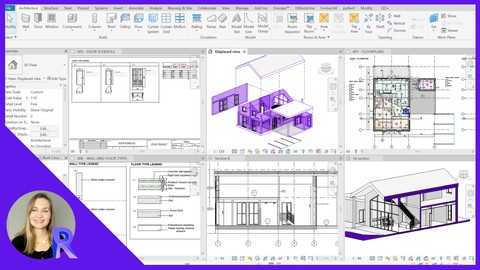
Beginner to Intermediate level in 10h – Autodesk Revit
Beginner to Intermediate level in 10h – Autodesk Revit, available at $44.99, has an average rating of 4.83, with 73 lectures, based on 29 reviews, and has 151 subscribers.
You will learn about Master Revit Basics: Learn foundational Revit skills for project management. Format Drawings: Prepare Revit drawings for printing or PDF, DWG export. Conduct Solar Study: Perform and analyze solar studies in Revit. Create Presentation Drawings: Produce engaging 3D sections and presentation drawings. This course is ideal for individuals who are Beginners who wants to learn Revit without previous experience. It is particularly useful for Beginners who wants to learn Revit without previous experience.
Enroll now: Beginner to Intermediate level in 10h – Autodesk Revit
Summary
Title: Beginner to Intermediate level in 10h – Autodesk Revit
Price: $44.99
Average Rating: 4.83
Number of Lectures: 73
Number of Published Lectures: 73
Number of Curriculum Items: 73
Number of Published Curriculum Objects: 73
Original Price: $69.99
Quality Status: approved
Status: Live
What You Will Learn
- Master Revit Basics: Learn foundational Revit skills for project management.
- Format Drawings: Prepare Revit drawings for printing or PDF, DWG export.
- Conduct Solar Study: Perform and analyze solar studies in Revit.
- Create Presentation Drawings: Produce engaging 3D sections and presentation drawings.
Who Should Attend
- Beginners who wants to learn Revit without previous experience.
Target Audiences
- Beginners who wants to learn Revit without previous experience.
Imagine stepping into the world of architecture and engineering with Revit, a powerful tool. This course will guide you from the basics to advanced techniques, all while designing a beautiful single-family house.
The Journey Begins: Introduction
We start with the essentials. Learn how to install Revit and explore its interface. Picture yourself opening Revit for the first time, discovering its menus and panels, feeling the excitement of the possibilities ahead.
Building the Foundation: Main Elements in Revit
Next, dive into the main modeling elements. Imagine placing walls, floors, roofs, ceilings, doors, windows, and more. You’ll gain confidence to tackle any project, big or small.
Crafting the Blueprint: Project Documentation
As our house takes shape, focus on documenting the project. Create precise 2D drawings and schedules detailing every aspect of your design. Learn to provide accurate material quantities and information to clients and contractors.
Bringing Designs to Life: Visualization
With the structure and documentation in place, bring your design to life. Showcase your work with stunning visualizations—solar studies, 3D sections, and displaced views. Improve your ability to communicate your vision.
The Final Touch: Create Sheets and Print
Conclude with the finishing touches. Create professional sheets, custom title blocks, and export your drawings in PDF and DWG format. Picture holding the final printed plans, a tangible result of your hard work and creativity.
Along the Way
Throughout the course, you’ll:
– Place Basic Elements: From walls to trees, every element finds its place in your design.
–Create Detailed Drawings: Bring plans, elevations, and sections to life with detailed annotations.
–Schedule Elements: Ensure every material and component is accounted for, providing essential information to stakeholders.
– Enhance Communication: Use advanced visualization tools to present your designs clearly.
–Finalize Drawings: Prepare your designs for presentation and construction with professional-grade sheets and exports.
By the end of this journey, you’ll have designed a complete house and gained the skills to use Revit successfully in any project. This course is more than a series of lessons—it’s a story of creation, from the first click to the final print.
Course Curriculum
Chapter 1: O1 INTRODUCTION
Lecture 1: How to install Revit
Lecture 2: Revit START view
Lecture 3: Revit templates
Lecture 4: Revit Interface
Lecture 5: Shortcuts and Background
Chapter 2: 02 MAIN ELEMENTS IN REVIT
Lecture 1: Grids and levels
Lecture 2: Alternative level
Lecture 3: Place Columns
Lecture 4: Introduction to Walls
Lecture 5: Placing external walls in sample project
Lecture 6: Interior partition walls
Lecture 7: Walls – Move and Align
Lecture 8: Basic tools
Lecture 9: Introduction to Floors
Lecture 10: Placing Floor at 2nd level
Lecture 11: Introduction to Roofs
Lecture 12: Placing Roof in sample project
Lecture 13: Introduction to Windows
Lecture 14: Windows library & Types & Create Section
Lecture 15: Introduction to Doors
Lecture 16: Wall openings – 3 ways to do it
Lecture 17: Introduction to Stairs
Lecture 18: Placing Stairs in sample project
Lecture 19: Railings
Lecture 20: Ramps
Lecture 21: Introduction to Curtain Walls
Lecture 22: Curtain Wall custom design
Lecture 23: Curtain Wall in sample project
Lecture 24: Ceilings
Lecture 25: Lighthing
Lecture 26: Introduction to Toposurface and siteplan
Lecture 27: External pavements
Lecture 28: Introduction to Model In-Place Components
Lecture 29: Introduction to Families
Lecture 30: Introduction to Mass for concept design
Chapter 3: 03 PROJECT DOCUMENTATION
Lecture 1: Elevations
Lecture 2: Floorplan formating
Lecture 3: View range from level below
Lecture 4: Callouts
Lecture 5: Dimensions
Lecture 6: 2d and 3d Lines
Lecture 7: Filled and Masking regions
Lecture 8: Components
Lecture 9: Insulation batt
Lecture 10: 2d and 3d Text
Lecture 11: Break line
Lecture 12: Room tags
Lecture 13: Area plans
Lecture 14: Hide room separation line
Lecture 15: Color fill Legend
Lecture 16: Wall tags
Lecture 17: Floor tags
Lecture 18: Window tags
Lecture 19: Door tags
Lecture 20: Ceiling tags
Lecture 21: Room schedule
Lecture 22: Wall Schedule
Lecture 23: Floor schedule
Lecture 24: Window schedule
Lecture 25: Door schedule
Lecture 26: Ceiling schedule
Lecture 27: Wall legend and Material tags
Lecture 28: Floor legend
Lecture 29: Door legend
Lecture 30: Window legend
Lecture 31: Graphical legend
Chapter 4: 04 VISUALIZATION
Lecture 1: Solar study
Lecture 2: Walkthrough
Lecture 3: 3d section
Lecture 4: Displaced 3d view
Chapter 5: 05 EXPORTING IN PDF AND DWG
Lecture 1: Place drawings on sheets
Lecture 2: Create your own titleblock
Lecture 3: Export drawings in pdf and dwg
Instructors
-
Lelde Savoni
Autodesk Revit Instructor with a decade of experience.
Rating Distribution
- 1 stars: 0 votes
- 2 stars: 0 votes
- 3 stars: 0 votes
- 4 stars: 6 votes
- 5 stars: 23 votes
Frequently Asked Questions
How long do I have access to the course materials?
You can view and review the lecture materials indefinitely, like an on-demand channel.
Can I take my courses with me wherever I go?
Definitely! If you have an internet connection, courses on Udemy are available on any device at any time. If you don’t have an internet connection, some instructors also let their students download course lectures. That’s up to the instructor though, so make sure you get on their good side!
You may also like
- Top 10 Financial Technology Courses to Learn in December 2024
- Top 10 Agile Methodologies Courses to Learn in December 2024
- Top 10 Project Management Courses to Learn in December 2024
- Top 10 Leadership Skills Courses to Learn in December 2024
- Top 10 Public Speaking Courses to Learn in December 2024
- Top 10 Affiliate Marketing Courses to Learn in December 2024
- Top 10 Email Marketing Courses to Learn in December 2024
- Top 10 Social Media Management Courses to Learn in December 2024
- Top 10 SEO Optimization Courses to Learn in December 2024
- Top 10 Content Creation Courses to Learn in December 2024
- Top 10 Game Development Courses to Learn in December 2024
- Top 10 Software Testing Courses to Learn in December 2024
- Top 10 Big Data Courses to Learn in December 2024
- Top 10 Internet Of Things Courses to Learn in December 2024
- Top 10 Quantum Computing Courses to Learn in December 2024
- Top 10 Cloud Computing Courses to Learn in December 2024
- Top 10 3d Modeling Courses to Learn in December 2024
- Top 10 Mobile App Development Courses to Learn in December 2024
- Top 10 Graphic Design Courses to Learn in December 2024
- Top 10 Videography Courses to Learn in December 2024






















